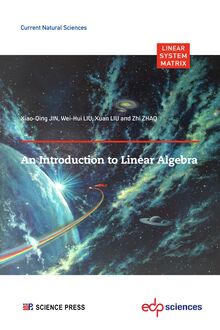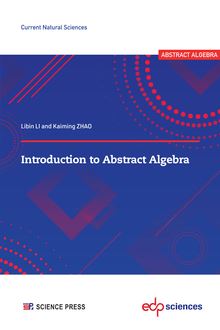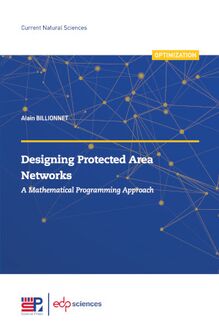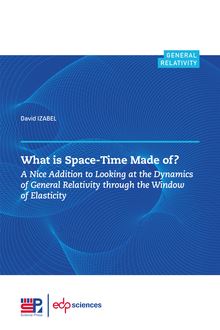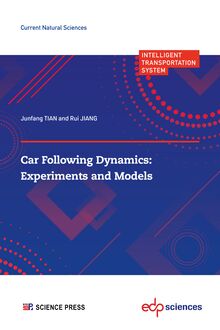The Milky Way , livre ebook
195
pages
English
Ebooks
2016
Obtenez un accès à la bibliothèque pour le consulter en ligne En savoir plus
Découvre YouScribe en t'inscrivant gratuitement
Découvre YouScribe en t'inscrivant gratuitement
195
pages
English
Ebooks
2016
Obtenez un accès à la bibliothèque pour le consulter en ligne En savoir plus
Publié par
Date de parution
10 mars 2016
Nombre de lectures
4
EAN13
9782759820016
Langue
English
Poids de l'ouvrage
7 Mo
Our knowledge of the Milky Way has been deeply renewed since a dozen years, following the results of the astrometric satellite HIPPARCOS, and those of large stellar surveys. Many concepts thought to be well established disappeared, to be replaced by others going towards a larger complexity: in particular, the discovery of radial migrations of stars has blurred the simple image that we had of the Galactic disk. There has been large progress in some domains, for instance the physics of the Galactic Center with its super-massive black hole; other problems remain unsolved, such as the nature of the dark matter existing like a halo around our Galaxy.
This book reviews our present knowledge of the Milky Way, in the simplest and most didactic way as possible. Basic notions are always recalled, which make the book accessible to readers without any advanced formation in astronomy. This basic work will be very helpful to understand the results expected from GAIA, the new ESA astrometric satellite launched on December 19, 2013.
Publié par
Date de parution
10 mars 2016
Nombre de lectures
4
EAN13
9782759820016
Langue
English
Poids de l'ouvrage
7 Mo
CURRENT NATURAL CURRENT NATURAL S SCIENCESCIENCES
F . Combes,
CURRENT NATURAL SCIENCES
The Milky Way
J. Lequeux
CURRENT NATURAL SCIENCES
The Milky Way
STRUCTURE, DYNAMICS, FORMATION
AND EVOLUTION
Françoise Combes and James Lequeux The Milky Way
ur knowledge of the Milky Way has been deeply renewed since a dozen years, following the
results of the astrometric satellite HIPPARCOS, and those of large stellar surveys. Many concepts Othought to be well established disappeared, to be replaced by others going towards a larger
complexity: in particular, the discovery of radial migrations of stars has blurred the simple image that STRUCTURE, DYNAMICS, FORMATION
we had of the Galactic disk. There has been large progress in some domains, for instance the physics
AND EVOLUTION of the Galactic Center with its super-massive black hole; other problems remain unsolved, such as
the nature of the dark matter existing like a halo around our Galaxy.
This book reviews our present knowledge of the Milky Way, in the simplest and most didactic way
as possible. Basic notions are always recalled, which make the book accessible to readers without
any advanced formation in astronomy. This basic work will be very helpful to understand the
results expected from GAIA, the new ESA astrometric satellite launched on December 19, 2013.
Book series edited by Michèle LEDUC and Michel Le BELLAC.
Françoise Combes is professor at College de France, and member of the French
Academy of Sciences. Her research activity at Paris Observatory covers a large range of topics
addressed in this book, with a predilection for numerical simulations.
Françoise Combes and James LequeuxJames Lequeux is Astronomer emeritus at Paris Observatory. His main domains of
expertise are the interstellar medium, star formation and galaxy evolution.
59 €
EDP Sciences : 978-2-7598-1915-7
www.edpsciences.org 9 782759 819157 CNRS Edition : 978-2-271-09168-0
315X235CollecangTurquoiseCarton.indd 3 15/02/2016 16:34Françoise Combes and James Lequeux
The Milky Way
Structure, Dynamics, Formation and Evolution
CURRENT NATURAL SCIENCES
EDP Sciences/CNRS ÉditionsCover illustration: Messier 109 (also called NGC 3992), a nearby galaxy
of similar morphology to the Milky Way, i.e. a clone of the Milky Way.
This barred spiral galaxy gives the right impression of how might look our
Galaxy, if seen face-on. © NOAO/AURA/NSF.
Printed in France
© 2016, EDP Sciences, 17 avenue du Hoggar, BP 112, Parc d’activités
de Courtabœuf, 91944 Les Ulis Cedex A
et
CNRS Éditions , 15, rue Malebranche, 75005 Paris.
This work is subject to copyright. All rights are reserved, whether the whole
or part of the material is concerned, specifically the rights of translation,
reprinting, re-use of illustrations, recitation, broad-casting, reproduction on
microfilms or in other ways, and storage in data bank. Duplication of this
publication or parts thereof is only permitted under the provisions of the
French Copyright law of March 11, 1957. Violations fall under the prosecution
act of the French Copyright law.
ISBN EDP Sciences: 978-2-7598-1915-7
ISBN CNRS Éditions: 978-2-271-09168-0Preface
What is this bright band across the sky? Although Democritus was
already thinking, in the 5th century BC, that the Milky Way was “made
of tiny heavenly bodies grouped so closely that they seem to us to be one”
(Achilles Tatius, quoted by Jean Salem, “Democritus”, our English
translation), it was not until Galileo and his telescope that this bold idea was
confirmed. Subsequently, the major obstacle to interpreting the observations,
even of excellent quality, in order to establish the size of our Galaxy and
the Sun’s position within it, was the poor determination of distances. It was
only in the 1930s that a correct representation of the Galaxy was obtained,
showing that the Milky Way was a galaxy among others, with a radius of
15 kpc (45,000 light years) for its stellar component, of about 20 kpc for its
gas component, and that the Sun was far from being at its center.
During the last two decades, new means of observation and new
computing facilities have opened new horizons: the advent of space astrometry with
the Hipparcos satellite of the European Space Agency (ESA) and its high
precision astrometric measurements for more than 100,000 bright stars and
very precise distances to 30,000 stars has led to a thorough knowledge of the
solar neighborhood and to revised cosmic distance scales; systematic
photometric observations over large areas of the sky such as the Sloan Digital
Sky Survey (SDSS) have led to the discovery of new stellar streams in the
halo; high-resolution spectroscopic observations with large telescopes have
led to a much better understanding of the chemical evolution of the Galaxy;
observation of millimeter and sub-millimeter waves has led to the discovery
of many new molecules in the interstellar medium; and finally increasingly
powerful computers have allowed increasingly detailed simulations of the
formation and evolution of galaxies.
The coming decade is once again full of promise with the operation of
satellites, telescopes and radio telescopes even more sensitive and / or more
accurate than their predecessors.
In the optical domain, the ESA Gaia satellite, successor to Hipparcos and
second astrometric satellite, was launched in December 2013. It will allow
a fantastic step forward in the knowledge of all the stellar components of
our Milky Way, with the identification and systematic measurement of one
billion objects brighter than magnitude 20, with astrometric precision still
50 to 100 times higher than that of Hipparcos and parallel observation of IV The Milky Way
their physical characteristics. Also in the optical domain, planned for the
early 2020s, the E-ELT (European Extremely Large Telescope) will observe,
in very great detail, very faint objects in our Galaxy and far beyond.
In the infrared, submillimeter and millimeter domains, essential
information is obtained about the formation of stars. After the spectacular results
of the Herschel European satellite, the mission of which completed in June
2013, ALMA (Atacama Large Millimeter / submillimeter Array), the global
network observing in the millimeter wavelengths, has become fully
operational. Later, the JWST (James Webb Space telescope), observing in the
near-infrared, is due to be launched in 2018 with the largest telescope ever
put into orbit, 6.5 m in diameter.
Finally, in the radio domain, extremely powerful for the study of the
interstellar medium and in particular the gas, the first light from the SKA
(Square Kilometer Array) project is expected in the 2020s.
A new golden age for astronomy, especially for the study of our Milky
Way and Local Group galaxies, the next decade promises to be full of
surprises and discoveries, and this book is precisely issued at the right time to
focus on our present knowledge before these new steps.
With the precision achievable by space astrometry, this ancient specialty
is now a vital tool for astrophysics (in the sense of the physical analysis of
the sources observed). It brings cosmic distance scales both for the stellar
and gaseous components, and the motions of stars in the solar
neighborhood. Soon, thanks to Gaia, these data will be available all across the Milky
Way and nearby galaxies. These observations provide clues to the structure
of the Galaxy and of its various components, but also to the kinematics and
dynamics of these, leading, for example, to a complete description of the
orbits of the stars in the Galaxy. Various correlations may now be studied
between the orbital characteristics (eccentricity, mean velocity, velocity
dispersion) of carefully selected groups of stars and the abundances of chemical
elements in their atmospheres. Only the combined study of these parameters
allows interconnection of the various traces left by the successive steps of the
formation and evolution of our Galaxy.
Astronomers are making progress in the understanding of our Milky Way
by assembling the various parts of this puzzle, by comparing these to the
characteristics of external galaxies, and by confronting all these observations
to increasingly detailed numerical simulations. Conversely, the Milky Way
is, of course, the galaxy studied in the highest detail (very accurate
distances and motions for many different types of stars, detailed abundances of
chemical elements in their atmosphere, detailed description of star forming
regions, determination of star orbits very close to the central black hole,
only to quote a few), and this provides an essential lighting in the
interpretation of much more global observations available for other galaxies.
The book of Francoise Combes and James Lequeux takes us step by step
through this rapidly evolving field, with a fascinating description of the Preface V
present state of our knowledge. The two authors, internationally recognized
specialists of the dynamics of galaxies and of the interstellar medium, both
have a very broad culture in astronomy and perfect clarity of presentation.
They are already the authors of many books on astronomy for the specialist
as well as for the general public. This book will certainly become a reference
in the field. It is a remarkable introduction to the description of this set of
stars, gas and dust in which we live: Françoise Combes and James Lequeux
introduce here these complex topics in a form that is concise but very
educational, simple but thorough and rigorous. Student, specialist or simply
curious, this book will encourage the reader to further deepen their knowledge
and push some, I am sure, to embark on the adventure of research and of
the interpretation of the mass of data expected from the future instruments
of the 21st century.
Catherine TURON
Astronomer Emeritus at the Paris ObservatoryVI The Milky Way
The authors thank the

